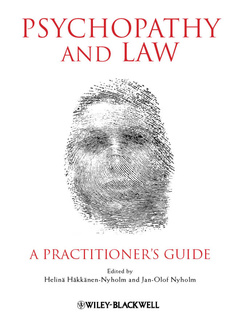Description
Psychopathy and Law
A Practitioner's Guide
Author: Häkkänen-Nyholm Helinä
Coordinator: Nyholm Jan-Olof
Language: English
Subject for Psychopathy and Law:
Keywords
difficult; psychopathy; treat; surprise; mind; guides; practitioners; behavior; strategies; require; unique; guide; fields; law; facets; introduction; comprehensive; ways; case; influencemaking; examine; persons; psychopathic
Publication date: 04-2012
314 p. · 17.5x25.2 cm · Hardback
Publication date: 04-2012
320 p. · 16.5x24.1 cm · Paperback
Description
/li>Contents
/li>Biography
/li>
- Features case examples and - unique from previous texts in the field - links these to theory and empirical research
- Represents an up-to-date resource for scientists examining psychopathy
- Covers issues that have never been dealt with in regard to psychopathy, including those relating to families, civil law, war crimes, economical crimes and organized crimes
About the Contributors xiii
Preface xix
1Introduction 1
Helinä Häkkänen-Nyholm and Jan-Olof Nyholm
The Nature of Psychopathy 1
Short History 5
Measurement 5
Practical Application and Study Populations 7
Future Directions 8
The Structure of This Text 9
References 12
2Assessment 17
Michael J. Vitacco, David A. Lishner, and Craig S. Neumann
Psychometric Properties of PCL Instruments 19
Psychopathy and the Law: Focus on the Insanity Defense 22
Potential Misuses of PCL Instruments in Legal Proceedings 25
Admissibility of PCL Instruments in Adversarial Proceedings 27
Ethical Issues with PCL Measures and Predicting Risk 29
Myths Associated with Psychopathy 30
Summary and Conclusions 32
References 32
3Psychopathy and Brain Function: Empirical Findings and Legal Implications 39
Christopher Patrick, Noah C. Venables, and Jennifer Skeem
Introduction 39
Diagnostic Distinctions 40
Brain Measurement Techniques 43
Neuroimaging Studies of Psychopathy 45
Electrocortical Studies of Psychopathy 60
Key Assumptions in Research on Brain Function in Psychopathy That Constrain Stability, Interpretation, and Practical Utility of Findings 65
Acknowledgements 70
References 71
4Cognition–Emotion Interactions in Psychopathy: Implications for Theory and Practice 79
Arielle R. Baskin-Sommers and Joseph P. Newman
Theoretical Perspectives on Psychopathy 80
Practical Issues in Psychopathy 86
Judicial Practice: Culpability and Post-incarceration Release 88
Treatment 91
References 92
5Psychopathy inWomen: Presentation, Assessment, and Management 99
Caroline Logan and Ghitta Weizmann-Henelius
Introduction 99
The Construct of Psychopathy and Its Presence inWomen 100
How PsychopathicWomen Present 104
The Practical Management ofWomenWith Psychopathic Traits 112
Future Directions in Practice and Research 118
References 120
6Psychopathic Features in Adolescence 127
Nina Lindberg
Personality Disorder in Adolescence 127
The Relationship of Psychopathic Traits in Childhood and AdolescenceWith Conduct Disorder and Antisocial Personality Disorder 128
Biological Factors 128
Psychosocial Factors 130
Psychopathic Traits and Juvenile Criminality 130
Stability of Psychopathic Traits 131
On Treatment 133
References 134
7Psychopathy and Violent Crime 139
Mary Ellen O’Toole and Helinä Häkkänen-Nyholm
Psychological Analyses of Violent Behavior 141
Psychopathy and Law Enforcement 142
Base Rate of Psychopathy in Criminals 143
Crime-related Behavior 145
How to Identify Psychopaths From a Pool of Suspects 149
Concluding Remarks 152
References 152
8Predatory Violence and Psychopathy 159
J. Reid Meloy
The Science of Predatory Violence 160
Measurement 163
Predatory Violence and the Psychopath 165
Legal and Judicial Issues 168
TheWay Forward: Future Research and Applications 170
References 171
9Psychopathy in Economical Crime, Organized Crime, andWar Crimes 177
Helinä Häkänen-Nyholm and Jan-Olof Nyholm
Economical Crime 179
Organized Crime 183
War Crimes 192
Future Research and Practical Applications 197
References 199
10Forever a Psychopath? Psychopathy and the Criminal Career Trajectory 201
Julia Shaw and Stephen Porter
Introduction 201
Psychopathy in Children and Youth 205
Violent Offending 209
Sex Offending 212
Conclusion 214
References 214
11Psychopathy in Prisons 223
Hannu Lauerma
Introduction 223
The Offending Psychopath and Society 224
Psychopathy and the Prison Staff 226
Psychiatric Care 228
Measures Against Psychopathic Behavior 232
References 234
12Psychopathy in Families: Implications for Clinical Interviews and Civil Proceedings 235
Helinä Häkkänen-Nyholm
Intimate Relationships 237
Parenthood 245
Working with Psychopaths in a Clinical Setting 248
Manifestation of Psychopathy in Civil Proceedings 251
References 256
13 Interpersonal Aspects and Interviewing Psychopaths 261
Jan-Olof Nyholm and Helinä Häkkänen-Nyholm
Introduction 261
The Psychopath’s Interpersonal Behavior 264
Deception and Manipulation 267
Threat of Violence 272
Practical Tips for Interviewing Psychopathic Individuals 273
References 279
Index 287
Jan-Olof Nyholm is a founding member and the Chairman of PsyJurdica Ltd. He has more than 30 years of experience in law enforcement (both at an international and national level), and has published several works on psychopathy and interviewing.




